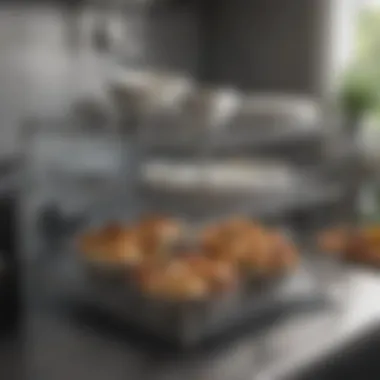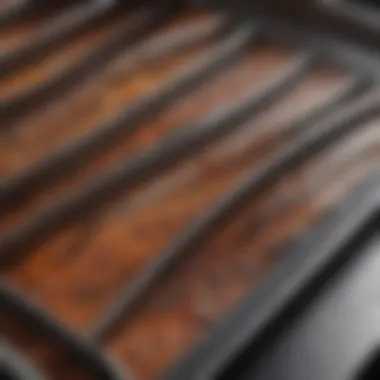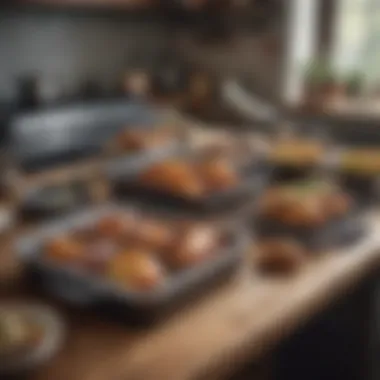Racks and Roasting Pans: Essential Tools for Home Cooking


Intro
In the culinary universe, racks and roasting pans are unsung heroes. Often tucked away in cabinets or buried beneath a pile of bakeware, these tools play a crucial role in creating delicious meals. They may seem basic at first glance, but their versatility stretches far beyond their primary functions. Understanding their design and construction can open a new world of cooking possibilities.
Racks, often used for cooling baked goods or allowing air circulation for roasts, come in various materials like stainless steel and non-stick varieties. Meanwhile, roasting pans, usually deeper to catch drippings, are vital for preparing succulent meats and veggies. The materials and design of these items not only influence cooking effectiveness but also the presentation of your dishes.
This article aims to highlight how to make the most of racks and roasting pans, from selecting the right tools to maintaining them in top shape. By digging into their practical applications and creative uses, we hope to elevate not just your cooking, but your entire culinary experience at home.
As we delve deeper into this exploration, be prepared to uncover tips and techniques that will transform the way you view these essential kitchen items.
Understanding Racks: An Overview
In the realm of home cooking, racks serve as much more than mere accessories; they are foundational tools that enhance both functionality and versatility in the kitchen. Understanding the different types of racks available not only aids in effective cooking but also elevates the overall culinary experience. Racks help organize and optimize oven space, enabling an efficient cooking process. They facilitate uniform cooking, cooling, and even storing meals, making them indispensable.
When one considers the importance of racks, they often think of how essential they are for achieving the perfect texture in baked goods or ensuring that meats roast evenly. A well-designed rack can provide the right altitude from the heat source, allowing hot air to circulate for optimal results.
Types of Racks
Cooling Racks
Cooling racks are primarily designed to allow baked goods to cool evenly, preventing sogginess. A key characteristic of cooling racks is their elevated grid design, which promotes airflow all around baked items, hastening the cooling process. This is especially useful for items like cookies and cakes that may retain moisture if left on a flat surface.
The unique feature of cooling racks is that they often come in various sizes, allowing for greater flexibility when, say, you’ve baked multiple trays of cookies. The ability to stack them for saving space is another advantage. However, one downside could be their material; they can be prone to rust if not properly maintained.
Roasting Racks
Roasting racks are specifically crafted for juices to drip away while simultaneously allowing heat to circulate around meat. This characteristic makes them extremely valuable for achieving a golden-brown finish on roasts. When it comes to cooking a turkey or a prime rib, using the appropriate roasting rack can mean the difference between a dry meal and one bursting with flavor.
What sets roasting racks apart is their sturdy design. Most are made from metal, giving them the heft to support larger cuts of meat without warping under high oven temperatures. However, users should be aware that these racks can be difficult to clean if food gets stuck.
Baking Racks
Baking racks often serve a dual purpose: they can act as cooling racks while also being used during the baking process to create a layered approach to cooking. Their robust grid-like structure allows heat to reach each item evenly, making them beneficial for baking multiple trays at once.
One major advantage is the ability to segregate various items such as pastries and entrees while cooking simultaneously. However, they also can have smaller spaces between the grids, which may not suit all types of baked goods as they could slip through the gaps.
Materials Used in Racks
Metal Racks
Metal racks are a stalwart choice for their heat resistance and durability. These racks can handle high temperatures without buckling, making them ideal for serious cooks who roast frequently. Their versatility allows them to fit almost any kitchen setting—from baking to broiling to even grilling indoors.
The combination of sturdiness and resistance to warping makes metal racks a favorite among many home cooks. However, they may require extra care to prevent scratches and tarnishing, depending on the finish.
Silicone Racks
When it comes to flexibility, silicone racks stand out. These racks are typically lighter, making them easier to handle. Moreover, their non-stick nature helps keep food from adhering during cooking, which eases cleanup.
On the downside, they may not provide the same sturdy support for heavier items compared to metal or ceramic options. This can result in some limitations, especially when it comes to cooking larger roasts.
Plastic Racks
Although perhaps not the go-to choice for heat-based cooking, plastic racks excel in serving as multi-purpose kitchen tools. Their lightweight nature allows for easy movement and storage, making them perfect for activities like meal prep or organizing utensils. They often come in vibrant colors, adding a fun aspect to kitchen routines.
However, plastic racks do have limitations concerning heat resistance and should never be used in the oven. Their potential to warp under heat makes them less suitable for high-temperature cooking tasks.
Design Features of Racks
Grid Patterns
The grid patterns of racks can vastly influence cooking results. Uniform grid designs allow for better airflow, ensuring even cooking while simultaneously facilitating cooling. This characteristic is universally beneficial regardless of whether one is baking or roasting.
However, one needs to keep in mind that a grid that's too wide may allow smaller items like vegetables to slip through, posing a potential challenge during cooking.
Adjustable Heights
Adjustable height features confer an added layer of versatility. This design element enables users to customize the rack's position based on the specific task at hand, be it for roasting in a large oven or baking multiple trays in a compact space.
Nonetheless, the added functionality may come at a cost; some adjustable racks may feel less stable than fixed ones, particularly when supporting heavier items.
Non-stick Surfaces
Racks with non-stick surfaces have become increasingly popular due to the ease of cooking and cleaning they provide. These surfaces minimize the sticking of food, which makes for less hassle during mealtime preparations.
Still, users should be cautious that these non-stick coatings may wear off over time, especially if treated with harsh cleaning methods. Regular, gentle cleaning is key to maintaining their efficiency.
"Understanding the nuances between different rack types and materials can make a significant difference in the outcome of your culinary efforts."
Each of these elements contributes to the robust utility of racks in home cooking. The right choice can bring a noticeable transformation to your kitchen endeavors.
Exploring Roasting Pans: Essential Tools in Cooking
Roasting pans play a pivotal role in home cooking, adding a layer of flexibility and functionality that set the stage for a multitude of culinary performances. From cozy weeknight dinners to elegant holiday feasts, these pans become more than mere vessels for cooking; they are instruments that enhance flavors while providing a convenient way for preparation and presentation. Understanding the varieties of roasting pans available and their specific traits can greatly influence your cooking efficiency, creativity, and overall enjoyment in the kitchen.
Different Styles of Roasting Pans
Standard roasting pans
Standard roasting pans are often the heavyweight champions of the kitchen. They are typically sturdy, larger pans geared for everything from roasting meats to baking lasagna. One standout aspect of these pans is their depth, which allows for substantial liquid to accumulate, capturing those all-important drippings that can enrich delicious gravies. Home cooks often find them indispensable as they allow for easy browning of dishes while still providing ample space for side vegetables.
While these pans generally are a pleasing choice for most cooks, a buyer should keep in mind that they do require adequate oven space; squeezing a large pan into a smaller oven is a challenge. A thoughtfully designed standard roasting pan offers an extensive area that ensures even cooking, making it a well-rounded choice.


Enamel-coated pans
Enamel-coated pans bring a colorful twist to traditional roasting. Made from metal or cast iron and coated with a layer of enamel, these pans are not only visually appealing but also practical for a variety of cooking tasks. Their glossy finish aids in non-stick properties, and cleaning them is often a breeze compared to their uncoated counterparts. Their vibrant colors can even add a pop of something special to your dining table.
However, despite their appealing features, it's worth noting that enamel can chip or scratch if not cared for properly. For this reason, they are best suited for moderate cooking techniques rather than heavy-duty use. Still, for those looking to infuse a bit of style into their kitchen, enamel-coated pans are a popular and beneficial choice.
Non-stick roasting pans
When you want hassle-free cleanup and minimal sticking, non-stick roasting pans come to the rescue. The secret sauce here is the non-stick coating, which allows for easy release of food as well as a simple wipe-down after cooking. They often perform well under high temperatures, making them suitable for roasting and crisping.
However, one must be cautious about using metal utensils with these pans as they can easily scratch the coating. Over time, if the coating wears and tears, it can lead to food sticking more and more. Thus, while they offer immediate convenience, their longevity can be in question. Still, within the realm of quick healthy meals, non-stick roasting pans have made a sure mark.
Materials for Roasting Pans
Stainless steel roasting pans
Stainless steel roasting pans are often heralded for their durability and heat resistance. This material excels in terms of food safety, providing a non-reactive surface that won't alter the flavors of your food. The shiny finishes can also contribute to a nice aesthetic in kitchen displays.
Importantly, stainless steel pans often present an even heat distribution, which is crucial for achieving that lovely golden-brown crust we all crave on roasted meats. A potential downside is their propensity to stain or show scratches over time, but many users believe the advantages outweigh these concerns, making stainless steel a well-regarded option for home chefs.
Ceramic pans
Ceramic roasting pans have become an enduring favorite, credited with offering excellent heat retention and even cooking. They are naturally heavy, which makes them stable during cooking. A significant benefit of ceramic is its ability to transition from oven to table, making for an elegant presentation.
On the flip side, ceramic can be breakable and should be treated with care. Some may find them too heavy when transferring in and out of the oven. However, if you are looking for both functionality and aesthetic appeal, ceramic pans offer significant merits that align with a refined cooking approach.
Cast iron roasting pans
Cast iron roasting pans stand out in their capability to hold heat exceptionally well. Known for their robust construction, they offer fantastic versatility, allowing you to use them on the stovetop or in the oven. Cast iron pans are celebrated for producing even browning, and they can help enhance flavors over time as they develop their own unique seasoning.
Still, they require maintenance to prevent rust and aren't as lightweight as other options. Users should beware of potential reactive qualities with acidic foods. However, many seasoned cooks swear by cast iron for its longevity and performance, making it crucial in a serious cook's toolkit.
Functional Features in Roasting Pans
Handles and grips
Handles are perhaps an underappreciated aspect of roasting pans. Good handles allow for easy maneuvering from the oven to counter without fear of burns or spills. Look for pans with sturdy, ergonomic grips that give you a secure hold. This can be especially important when removing a heavy roast from the oven; you wouldn't want to risk dropping dinner!
The key takeaway here is to ensure that your pan has adequate handles that reflect a well-thought-out design. Such features can make all the difference in comfort and safety during your cooking tasks.
Drip pans
Drip pans are an ingenious addition to roasting pans, adding to their overall functionality. These pans sit below the main cooking surface to catch excess fat and juices, which can then be transformed into your gravy or sauce. This adds flavor, and you'll appreciate the ease of cleaning up afterward; nobody likes scrubbing burnt-on bits!
However, it’s essential to select a pan with a well-designed drip mechanism to capture these drippings effectively. In doing so, your culinary efforts will yield not just delicious outcomes but also manageable cleanup.
Built-in rack systems
Lastly, built-in rack systems offer another layer of utility to roasting pans. These racks elevate the food above the base of the pan, allowing heat and air to circulate effectively. This results in better browning and crisping of your dishes, a non-negotiable aspect for many cooking enthusiasts.
While built-in racks provide undeniable advantages, users should check their sturdiness; flimsy racks can lead to accidents, compromising safety and cooking success. A well-designed baking system enhances the roasting experience dramatically, making it a sought-after feature in modern ovens.
"In the kitchen, what you use can often be just as important as how you use it. Selecting the right roasting pan can dramatically elevate your cooking!"
The exploration of roasting pans thus encapsulates more than just functionality; it encompasses style, durability, and practicality—vital elements for any serious home chef.
The Synergy Between Racks and Roasting Pans
Racks and roasting pans are not merely separate kitchen tools; rather, they form an essential duo in the culinary space. Their combined use can elevate both the quality of your cooking and the beauty of your presentation. Understanding how these instruments work together will enhance your cooking experience, making it not just simpler, but also more efficient.
Culinary Techniques Benefiting from Their Combination
Even heat distribution
Even heat distribution is crucial in ensuring your meals are cooked evenly. When using a rack atop a roasting pan, heat from the oven circulates around the food, allowing for consistent cooking on all sides. This method can significantly reduce the chances of undercooked areas, maintaining a delightful texture throughout the dish.
The standout characteristic of even heat distribution is its ability to yield a uniformly cooked product without dry patches or burnt edges. This yields a superior flavor and texture, making it a common choice among culinary enthusiasts.
Additionally, an important aspect is how this technique aids in roasting vegetables alongside meats without worry. They each come alive in flavor without competing aromas. One disadvantage might be the initial learning curve in managing oven temperatures properly to get the most out of this synergy.
Fat drippings capture
Using a roasting pan with a rack also excellent at fat drippings capture. This feature allows the excess fat rendered from meats to drip away, which not only results in a far healthier dish, but also provides the base for a rich, flavorful gravy.
The ability to collect these drippings is favored by home cooks aiming for enhanced flavors. When you make a staff or sauce from these drippings, the resulting flavor becomes vibrant and full-bodied, taking your dishes to another level.
However, while it can amplify flavor profiles, measuring out the right amount of fat post-roasting could sometimes be tricky.
Enhanced airflow
Another significant benefit of using racks with roasting pans is enhanced airflow around the food. This airflow reduces cooking times and ensures that food crispiness—especially for items like chicken skins or roasted potatoes—comes through brilliantly.
The key feature here is that air passes freely around the food, creating a delightful layer of crispy texture. This characteristic is particularly beneficial for those who enjoy achieving a golden, crispy finish without excessive oil.
On the flip side, if not monitored carefully, enhanced airflow can lead to food drying out. Thus, attention should be given to timing in the oven.
Maximizing Cooking Efficiency
Batch cooking strategies
Batch cooking stands to gain significantly when using the robust combination of racks and roasting pans. Preparing several trays of food at once not only saves time but also keeps energy consumption low. When you roast multiple items concurrently, food flavors can meld beautifully together.


The essential aspect of batch cooking through this method is the acceleration of meal prep. Often, this strategy is favored by busy households wanting to ensure a week’s worth of nutritious meals prepped in advance.
However, cooks should consider the oven space and temperature requirements as they strategize for bulk dishes.
Reducing cooking times
Reducing cooking times is another noteworthy advantage of using racks and roasting pans in tandem. The increased airflow and even heat distribution allow for quicker cooking, letting you get meals on the table in less time.
This feature is especially significant for home cooks facing time crunches. Being able to achieve tender, juicy outcomes quickly is a prime reason this cooking method has become prevalent.
Nonetheless, cooks must be cautious about not overcooking or burning their meal due to the faster pace of cooking.
Easy seasoning application
Lastly, easy seasoning application is a real boon when working with racks and roasting pans. Seasoning food directly on a rack means that the spices are not just stuck to the bottom of the pan, but evenly distribute throughout the food as it cooks, enhancing flavor more holistically.
The hallmark of this method lies in its ability to maximize flavor with minimal fuss. This approach supports a creative kitchen experience, proving to be advantageous for those who like to experiment with different seasonings.
However, attention must be given to ensure that excess seasoning doesn’t cause unintended flavors or potential burning, as some spices can become bitter when overheated.
In summary, the synergy between racks and roasting pans invites cooks to explore new culinary heights while achieving practical benefits. Their cooperative function allows for enhanced cooking techniques, leading to delicious outcomes and an overall improved culinary experience.
Selecting the Right Rack and Roasting Pan
When it comes to home cooking, selecting the right rack and roasting pan is like choosing the right instruments in an orchestra. Each piece plays its part in creating culinary harmony, ensuring that your dishes come out just right. This section will delve into critical elements like size compatibility, heat resistance, and durability, shedding light on how these factors can elevate your cooking game.
Size and Compatibility Considerations
Capacity based on family size
Choosing the right capacity for rack and roasting pans based on family size is vital for optimal cooking performance. A small roasting pan can lead to uneven cooking or insufficient space for your meals. For instance, if you often cook for a larger family or host gatherings, a larger pan is beneficial. It allows ample room to cook multiple items at once, such as meats and veggies. This key characteristic—size that accommodates your family—ensures that everyone gets fed happily.
Moreover, a larger capacity often means better heat distribution, as there’s enough space to allow hot air to circulate freely around the food. However, a too-big pan may take extra oven space and become daunting to store. So be mindful of your kitchen's layout and storage options.
There’s always room for versatility
Investing in versatile racks and roasting pans is a no-brainer for any home cook. A versatile pan can often transition from a roasting dish to a baking tray, saving space and money. This flexibility allows you to use the same tools for preparing a variety of dishes, such as lasagna or baked ziti, and even for roasting a chicken.
The uniqueness here is in the dual function of such tools, making them incredibly popular among both seasoned chefs and amateurs alike. While versatility is a tremendous advantage, it can sometimes compromise specialized performance. A pan built specifically for roasting might do a better job at it than a multi-functional one. Thus, understanding when to employ which tool is key.
Measuring your oven space
Understanding your oven space is integral for the successful use of racks and roasting pans. Imagine buying a beautiful roasting pan only to find out it doesn’t fit! That's where proper measurements come into play. Knowing the dimensions of your oven allows you to choose a rack and roasting pan that fit snugly without blocking heat circulation.
Taking the time to measure your oven's interior is a simple yet often overlooked task. The advantage here is twofold: you avoid the disappointment of a poor purchase and ensure better cooking efficiency. Even if a pan looks magnificent, if it doesn't fit, you’ll find it relegated to a cupboard corner.
Understanding Heat Resistance and Longevity
Temperature tolerance
Temperature tolerance is a crucial aspect when considering racks and roasting pans. Most home cooks often push the limit when it comes to how hot they can set their ovens. Using equipment that can endure high temperatures without warping or damaging is necessary.
It’s beneficial to notice the temperature ratings that manufacturers provide. High-temperature tolerant materials, like stainless steel or heavy-duty aluminum, can handle the heat well while creating superb browning effects on your dishes. On the flip side, using a pan that can’t tolerate the heat might lead to chipping or altered flavors, ruining your culinary masterpiece.
Durability against wear and tear
When you invest in kitchen tools, especially racks and roasting pans, you want them to last. Durability against wear and tear is paramount. Look for materials that resist scratches and dents. For example, a heavy cast iron roasting pan can withstand numerous culinary sessions without losing its form or functionality.
While more affordable options may seem tempting, they can quickly show signs of wear, leaving you with a need to replace them sooner than expected. Durable products offer worthwhile benefits, providing long-term usage without frequent replacements. It’s an investment that pays off.
Manufacturer warranties
Never underestimate the importance of manufacturer warranties when selecting racks and roasting pans. A good warranty reflects confidence in the product's durability and quality. If something does go south, you want the peace of mind that comes with being covered.
This characteristic emphasizes the manufacturer’s commitment to standing behind their product. Many reputable brands offer warranties ranging from one year to lifetime coverage. This is another angle where understanding your purchase adds value. Knowing you have that safety net can allow you to use your kitchen tools without worry.
Maintenance Tips for Racks and Roasting Pans
Maintaining racks and roasting pans is vital for any home chef who wants to keep their kitchen tools in tip-top shape. Proper care not only extends the lifespan of these items but also enhances their performance during cooking sessions. A well-maintained pan or rack can make a world of difference when you're preparing a meal. Here are some essential maintenance tips to keep in mind.
Cleaning Methods for Different Materials
Dishwasher-safe options
Using dishwasher-safe racks and pans can be a real game changer. It significantly reduces the time and effort needed to clean up after a big meal. Not only can you toss them in the dishwasher, but these items are also designed to withstand the heat and water pressure of a wash cycle without warping. One standout feature is often the durable coatings that resist scratches and stains. However, one must consider that some delicate items might not fare as well; they could lose their finish over time or become discolored. Regardless, for the everyday cook, this convenience makes dishwasher-safe options a popular choice.
Manual cleaning techniques
There are times when manual cleaning is the way to go, especially for tougher stains or baked-on grease. This method allows you to be thorough, applying just the right amount of elbow grease where it’s needed. A sponge and some soapy water is typically all that's required for moderate messes. In terms of unique features, customized brushes—like those with fine bristles—can be a real asset for cleaning intricate designs on racks. But, it's worth noting that manual cleaning can be time-consuming, and if not done carefully, it may lead to scratches or damage.
Preventing rust and corrosion
Preventing rust and corrosion is crucial, particularly for metal racks and pans. Regular cleaning and thorough drying after each use can significantly reduce the risk of moisture build-up, which is a breeding ground for rust. Additionally, using a light layer of oil, such as vegetable or mineral oil, on the surface can act as a protective barrier against oxidation. The unique characteristic here is that a simple step can save you from having to invest in replacements far too soon. However, it's essential to choose the right oils as some can react poorly to high cooking temperatures or leave residues.
Storage and Organization Strategies
Preventing scratches
When it comes to storing racks and pans, preventing scratches should be at the forefront. Scratches not only affect the appearance but can also make these items less effective over time. Lining shelves with soft cloths or using felt pads between items creates a barrier against friction. This simple adjustment can preserve the integrity of the finish and prolong usability. However, keep in mind that such methods require some initial investment of time or materials.
Stacking solutions


Utilizing stacking solutions can save a significant amount of space in your kitchen. Opting for racks designed to neatly stack together allows for efficient storage while avoiding clutter. This method is particularly beneficial in smaller kitchens where space is at a premium. A downfall, however, is that stacking can lead to issues if not done correctly—improper stacking could easily lead to unstable structures that may result in accidents when accessing your kitchen tools.
Utilizing kitchen space effectively
Incorporating tips for utilizing kitchen space effectively means thinking beyond just the storage. Consider using wall-mounted racks or hooks for those frequently-used items. This can declutter your countertops and keep everything within arm's reach. An innovative feature of this approach is that it not only opens up physical space but can also enhance the aesthetic of your kitchen. Nonetheless, one must be mindful that keeping essentials visible could lead to a slightly messy appearance if not curated well.
Innovative Uses Beyond Conventional Cooking
Exploring the world of racks and roasting pans reveals their flexible roles that extend far beyond traditional cooking methods. These kitchen tools can surprise with how they adapt to various innovative cooking techniques. This section unveils the rich tapestry of creative uses, focusing on aspects such as unique cooking methods and imaginative presentation techniques.
Creative Cooking Methods
Steaming vegetables
Steaming is not just a method; it's a culinary game changer. When it comes to steaming vegetables, using a rack in a pot can elevate this simple process. This technique allows steam to circulate freely instead of having the veggies sit in water. The leading characteristic of this method is its ability to preserve nutrients, ensuring that the health benefits of your greens remain intact.
Additionally, steaming veggies maintains their vibrant color and crisp texture, making them visually appealing. However, one must be careful; overcooking can lead to mushiness. That being said, steaming is a popular choice for those looking to whip up a quick, healthy side dish, fitting seamlessly into meal-prep routines. It's a method less explored but incredibly effective when using racks and pans creatively.
Grilling in the oven
Ever thought your oven could mimic outdoor grilling? Here’s where the magic happens. Grilling in the oven by employing a rack allows for heat to circulate effectively, making it possible to achieve that lovely char without firing up the grill. This technique shines especially for those living in places where outdoor grilling isn’t an option, such as apartments or colder climates.
The main feature here is the ability to employ indirect heat, which locks in flavors while browning the exterior beautifully. The downside is that it requires a bit of practice to get the timing right, as different foods cook at varying speeds. But for the adventurous cook, this method broadens the variety on your dinner table and brings that smoky flavor right into your home.
Broiling with racks
Broiling is somewhat akin to grilling but on the upper end of the oven and typically uses higher heat. When broiling with racks, the food can be placed closer to the heat source, enhancing cooking efficiency. The essential characteristic that makes broiling remarkable is its speed—foods cook rapidly, often within minutes, which is a boon for busy weeknight dinners.
Another advantage is the lovely caramelization it can achieve on meats and vegetables alike. That said, one must keep an eye on things, as it can also easily lead to burning. When time is of the essence, this method could be a the ultimate solution, highlighting the versatility of your racks together with roasting pans.
Presentation and Serving Techniques
Elegant serving platters
Presentation can make or break a meal. When incorporating elegant serving platters into the mix, you can transform a home-cooked dish into something that feels special. The allure of serving food on beautiful platters lies in their ability to draw eyes to the table. They come in various materials, colors, and designs, allowing you to match them with specific dining themes.
The distinct feature of using serving platters is their capacity to accommodate various dishes simultaneously, creating an inviting spread that encourages sharing. The only caution is to ensure that you select platters that complement the meal, as mismatched styles can diminish the overall aesthetic. Still, when done right, it enhances the dining experience immensely.
Staging food artfully
Staging food artfully is where creativity meets culinary presentation. More than just arranging food on a plate, it involves an artful approach to layout. To stage food effectively, one might use different height levels by adjusting racks or even utilizing cake stands. This adds depth and intrigue, catching the eye in a way that flat presentations cannot.
This method allows for a playful arrangement, encouraging diners to explore the array of flavors presented. It’s a fascinating choice for gatherings or special occasions, inviting participation in the experience. However, achieving balance and harmony in presentation requires practice. Yet, those who invest the time can leave a lasting impression on their guests.
Using racks for tiered displays
A tiered display using racks promotes elegance and creativity at the table. It not only maximizes space but also attracts attention with its well-organized vertical layout. The standout point here is that a tiered rack can hold various foods such as appetizers, desserts, or even drinks, creating an enticing buffet style that guests will appreciate.
One unique feature of using tiered displays is how it encourages interaction; diners can explore different food offerings. Yet the challenge lies in balancing visual appeal with accessibility, ensuring that every guest can enjoy the array without hassle. When successfully executed, it elevates both the food and the overall dining atmosphere, making it a sought-after choice for social occasions.
"Innovative uses of kitchen tools can transform not just how we cook, but how we experience our meals."
Through examining these innovative uses, we see that racks and roasting pans are not merely for traditional tasks; they hold the potential to enhance creativity in cooking and presentation. Their versatility offers homeowners the chance to try new techniques, making each meal a remarkable experience.
Concluding Remarks on Racks and Roasting Pans
In these final thoughts, it's essential to reflect on the significance of racks and roasting pans in home cooking. These tools are not just ordinary kitchen items; they play a pivotal role in how we prepare and present our meals. By understanding their versatility and functionality, we enhance not only the cooking process but also the overall dining experience.
The Impact on Culinary Experience
Enhancing flavors
Enhancing flavors is one of the foremost benefits of using racks and roasting pans. When food is elevated on a rack, it can circulate air and heat more evenly. This promotes proper browning, which in turn unlocks deeper, richer flavors that might otherwise remain hidden. One key characteristic of this method is the drainage of excess fat, which also helps achieve a healthier dish. Many cooks swear by this technique—it’s a tried-and-true way to make roast chicken and veggies sing with taste.
However, a unique feature of using racks is that they may require an initial learning curve. Understanding how to balance your food effectively while employing the rack system is crucial; otherwise, you face the risk of unsteady meals. Still, the rewards of flavor enhancements make it a worthy endeavor.
Streamlining meal prep
Next, let’s discuss streamlining meal prep. The use of racks and roasting pans allows for better organization of your cooking. With an appropriate rack, one can cook multiple items simultaneously without overcrowding. This efficiency—where you maximize space—reduces the time you spend in the kitchen.
One notable attribute of this convenience is batch cooking, making it particularly beneficial for busy households. Prepping meals in advance becomes feasible and less cumbersome. As options multiply, the risk of sloppy meal planning diminishes. But on the flip side, the need to have various sizes of pans for different needs could clutter your storage.
Creating memorable meals
Lastly, let’s touch upon the concept of creating memorable meals. A well-cooked dish, where every component sings, can turn an ordinary day into a gastronomic celebration. Racks and roasting pans facilitate that by presenting food in a way that's both visually appealing and rich in taste. By using layers and elevation offered by racks, you can showcase your culinary creativity. When guests enter your home, beautifully arranged roasted lamb or vibrant veggies can make a lasting impression.
However, achieving this level of presentation takes practice. Learning to artfully arrange food takes time, yet the satisfaction of serving a stunning meal makes the effort worthwhile. The aesthetic appeal has a unique power in any gathering; it creates a lovely atmosphere that enhances the dining experience.
Future Trends in Kitchenware Design
Smart technology in cooking equipment
As we look at the future of racks and roasting pans, smart technology in cooking equipment stands out. This technology allows for precise temperature control, making it easier to achieve the desired results with every dish. A crucial trait of smart devices is their ability to integrate with home networks, allowing for remote monitoring and adjustments. This trend is beneficial for tech-savvy cooks who appreciate a seamless cooking experience.
Nonetheless, there's a learning curve, and some individuals may find smart cooking gadgets intimidating. Yet, the convenience and control they offer are becoming harder to resist.
Sustainable materials in kitchenware
Then comes the shift towards sustainable materials in kitchenware. With a growing focus on eco-friendliness, many brands began to explore options like bamboo, recycled metals, and biodegradable options. This trend resonates with environmentally conscious homeowners, leading to a growing market for sustainable products. The key characteristic of this shift is that it truly assists in reducing waste while maintaining high performance in cooking.
However, some may raise concerns about the durability of these materials compared to traditional ones. While not every sustainable option may stand the test of time, innovation continues to refine these products, making them more reliable.
Customization options for personal kitchen styles
Finally, customization options for personal kitchen styles are also on the rise. Consumers are beginning to seek items that fit their unique tastes, with racks and roasting pans being no exception. This behavior reflects a broader trend of personalization in home decor, where individuals express their culinary identity through tailored items.
The unique feature here is having racks and pans designed to fit individual preferences, allowing for greater satisfaction. However, customizing items may sometimes come with added costs and lengthy wait times. Still, the individuality and personal touch they offer provide immense value.















